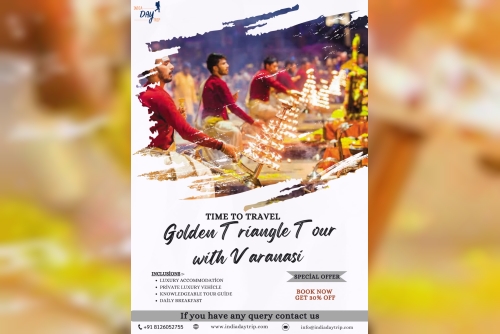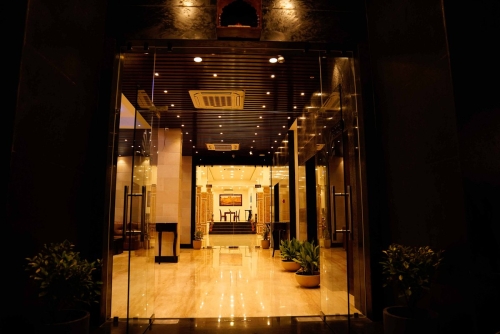The Golden Triangle Tour, encompassing Delhi, Agra, and Jaipur, is one of the most popular travel circuits in India. Extending this journey to Varanasi adds a spiritual dimension, offering an unforgettable experience. While Delhi, Agra, and Jaipur are known for their rich history, architecture, and culture, Varanasi is the spiritual heart of India, where the sacred Ganges River flows and ancient rituals are still practiced.
This tour combines the best of India’s past and present, making it a perfect choice for those looking to explore diverse aspects of Indian culture. From visiting historical monuments like the Taj Mahal and the Red Fort to witnessing spiritual ceremonies on the ghats of Varanasi, this journey promises to be both enlightening and immersive. Read on to discover what makes the Golden Triangle Tour with Varanasi a must for every traveler.
The Golden Triangle Tour refers to a travel circuit in North India that covers three key cities: Delhi, Agra, and Jaipur. These cities form a triangle on the map, each representing a different era and aspect of Indian history and culture. Delhi, the capital city, is a blend of ancient history and modern developments. Agra is home to the iconic Taj Mahal, a symbol of love and one of the Seven Wonders of the World. Jaipur, known as the Pink City, offers a glimpse into the royal heritage of Rajasthan with its majestic forts and palaces.
Together, these cities showcase the diversity of India’s culture, architecture, and history. For travelers looking to experience the essence of India in a short time, the Golden Triangle Tour is an ideal introduction to the country. With easy connectivity between the cities, this tour is perfect for both first-time visitors and those seeking a deeper understanding of India’s heritage.
While the Golden Triangle Tour is rich in history and culture, adding Varanasi to the itinerary introduces a spiritual dimension that enhances the overall experience. Varanasi is one of the oldest continuously inhabited cities in the world, often referred to as the spiritual capital of India. Situated on the banks of the sacred Ganges River, it is a major pilgrimage site for Hindus.
Travelers visiting Varanasi can witness ancient rituals performed on the ghats, participate in the mesmerizing Ganga Aarti ceremony, and explore the narrow alleys lined with temples and shops. The city offers a unique blend of spirituality, tradition, and daily life, making it a transformative experience for visitors. Extending the Golden Triangle Tour to include Varanasi provides a complete picture of India’s cultural and spiritual richness.
Delhi is a city of contrasts, where ancient landmarks coexist with modern marvels. Visitors can start their journey by exploring historical sites such as the Red Fort, Qutub Minar, and Humayun’s Tomb, all UNESCO World Heritage Sites. The bustling streets of Old Delhi, with its vibrant markets and street food, offer a glimpse into the city’s rich past.
For those interested in modern architecture, New Delhi’s wide boulevards, government buildings, and landmarks like India Gate and Rashtrapati Bhavan are a must-visit. Delhi’s cultural scene is equally vibrant, with numerous museums, art galleries, and theaters offering insights into India’s artistic heritage. Whether it’s exploring Mughal-era monuments or enjoying contemporary art, Delhi has something for every traveler.
Agra, located on the banks of the Yamuna River, is synonymous with the Taj Mahal, a UNESCO World Heritage Site and one of the most famous monuments in the world. Built by Emperor Shah Jahan in memory of his beloved wife Mumtaz Mahal, the Taj Mahal is a symbol of eternal love and architectural brilliance.
Beyond the Taj Mahal, Agra boasts other historical sites such as the Agra Fort and Fatehpur Sikri, both of which played a significant role in India’s Mughal history. Visitors can also explore the local markets, known for their marble handicrafts and traditional sweets like petha. A visit to Agra is incomplete without witnessing the beauty of the Taj Mahal at sunrise or sunset, when the monument’s white marble glows in the changing light.
Jaipur, the capital of Rajasthan, is known as the Pink City due to the distinct color of its buildings. This city is a treasure trove of architectural wonders, with its grand palaces, forts, and temples. One of the most famous landmarks is the Amber Fort, a sprawling complex built with red sandstone and marble, offering panoramic views of the surrounding hills.
The City Palace and Hawa Mahal, with their intricate facades and courtyards, showcase the royal heritage of Jaipur. Visitors can also explore the bustling bazaars of Jaipur, known for their textiles, jewelry, and handicrafts. Jaipur’s rich cultural heritage, combined with its vibrant markets and cuisine, makes it a highlight of the Golden Triangle Tour.
Varanasi, also known as Kashi, is one of the holiest cities in India and is often referred to as the city of temples. Located on the banks of the Ganges River, it is a major pilgrimage site for Hindus who believe that a visit to Varanasi can lead to salvation.
One of the most captivating experiences in Varanasi is the Ganga Aarti, a nightly ritual performed on the ghats of the river. The ceremony, involving fire, incense, and chanting, creates a mesmerizing atmosphere that attracts both locals and tourists. Visitors can also take a boat ride on the Ganges at sunrise, witnessing the daily rituals and life along the river. Varanasi is a city that offers a unique glimpse into India’s spiritual traditions and ancient culture.
The best time to visit the Golden Triangle with Varanasi is during the cooler months, from October to March. During this time, the weather is pleasant, making it ideal for sightseeing and outdoor activities. The summer months (April to June) can be extremely hot, especially in cities like Delhi and Jaipur, while the monsoon season (July to September) brings heavy rainfall, which can affect travel plans.
Visitors can also plan their trip around festivals like Diwali, Holi, and Durga Puja, which add a vibrant cultural element to the experience. However, it's important to book accommodations and tours in advance during these peak seasons.
Planning a Golden Triangle Tour with Varanasi requires careful consideration of travel time, key attractions, and personal preferences. Most itineraries start in Delhi, followed by visits to Agra and Jaipur, before heading to Varanasi. A typical tour lasts between 7 to 10 days, with 2-3 days spent in each city.
It’s advisable to book guided tours for historical sites and temples, as they provide valuable insights into the culture and history of each location. Additionally, including some leisure time for exploring local markets, trying regional cuisine, and experiencing the local way of life will enrich the travel experience.
To make the most of your Golden Triangle Tour with Varanasi, it's important to stay open to new experiences. Wear comfortable clothing, especially when visiting temples and monuments, and respect local customs and traditions.
Booking a sunrise boat ride on the Ganges in Varanasi or catching the sunset at the Taj Mahal are must-do activities. Finally, be sure to savor the local cuisine, from street food in Delhi to traditional Rajasthani thalis in Jaipur and sweets in Agra.
















